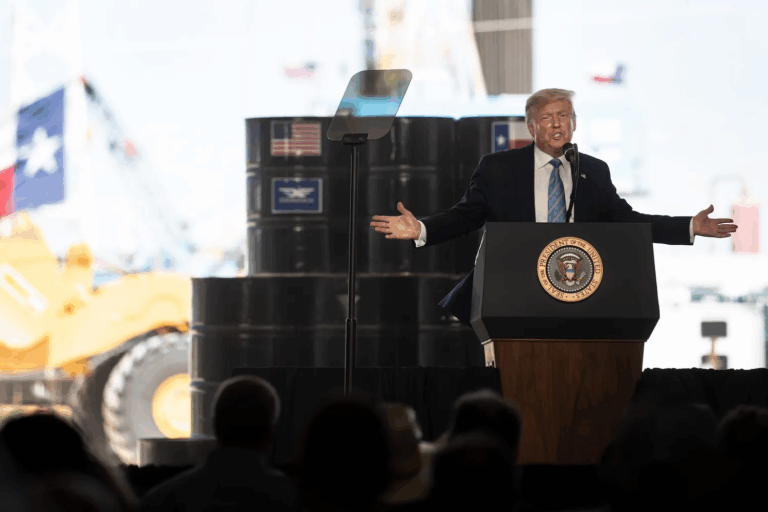This website uses cookies as well as similar tools and technologies to understand visitors’ experiences. By continuing to use this website, you consent to Columbia University’s usage of cookies and similar technologies, in accordance with the Columbia University Website Cookie Notice.
By Richard Nephew
What should we make of the announcement on July 17th that the Trump Administration is going to keep the United States in the Joint Comprehensive Plan of Action (JCPOA) with Iran, at least for the time being?
For some supporters of the JCPOA, this is a positive announcement. It can be seen as part of a broader decision to avoid rocking the boat with Iran right now. If press stories are to be believed, there is now a national security consensus within the Trump Administration that supports this. These JCPOA supporters will take comfort from the fact that, as this is the second time under Trump in which Iranian compliance with the JCPOA has been certified, the Trump team is growing used to having the nuclear deal around. And, in a larger sense, the maintenance of the JCPOA shows that expertise and factual analysis are still relevant in the U.S. government.
For others, of course, the continuation of the JCPOA is unwelcome news. There are those who are displeased because they believe that the broader U.S. interest lies in escaping from the JCPOA and its limitations on U.S. sanctions policy toward Iran that hamstrings our ability to address the larger problem of Iranian regional behavior. There are still others who believe this marks another lost opportunity to shift U.S. policy toward explicit support for regime change in Tehran, a possibility that has been discussed with alarming frequency in Washington and on the think tank circuit in recent months.
Taking a step back for a moment, I would stress two observations on the decision to extend the JCPOA:
- 1. Though some of the talk around the July 17th decision is stagecraft, the JCPOA remains in as much danger as it has been since Trump became president; and,
- 2. The JCPOA has been maintained because there are no good options to constrain Iranian nuclear developments short of the JCPOA and the Trump team is uncertain about partner support for U.S. policy absent the JCPOA.
But, the compromise decision that resulted from this process – with its reliance on other means to ratchet up pressure on Iran in other ways – may itself be destabilizing depending on how it is implemented. The JCPOA is alive today, but at risk for tomorrow.
Heading into a danger zone
Much of the talk around the JCPOA following its extension by Secretary of State Tillerson has centered on the reported debate within the White House on the day it was to be announced. Press reports indicate that Trump himself rejected the unanimous conclusion of his national security aides – Tillerson, Defense Secretary Mattis, Chairman of the Joint Chiefs of Staff Dunford, and National Security Advisor McMaster – that extension of the JCPOA was in the U.S. interest. Though, in the end, Trump relented and permitted extension to proceed, the extensive detail reported in the press underscores the degree to which this was a grudging, unhappy decision. Trump was less convinced of the merits of the case, perhaps, than he was of the risks in going against the advice that he was receiving.
If this were the only time in which Trump must make a decision on this matter, perhaps the implications of how the extension was accepted would be less significant. But, under the terms of the legislation mandating 90-day certifications like the one Secretary Tillerson just issued, the United States has now entered into yet another review period. In October, Trump and his national security team will have to consider this matter once again. Additionally, the United States will need to continue its process for renewing sanctions waivers, with oil-related sanctions due up once more in September. The decision on July 17 is thus no conclusion but rather the end of one chapter of a much longer book. Trump’s reported displeasure with the extension implies that, at any point in time, there could be a major plot twist.
From a functional perspective, the JCPOA could be annulled quickly and without much warning. It was designed to be primarily an executive-action-driven agreement and, as a result, it is dependent on the president’s own authorities for implementation and support. Nothing could stop Trump from halting certifications or cancelling sanctions relief. Based on reports out of the White House, it is precisely this sort of debate that took place ahead of the extension.
It is possible that the press reports about the debate within the White House are all part of a larger strategy that would convince Iran and the international community that the JCPOA is hanging on by a thread, with the actual desired end state being that U.S. partners that support the deal become so frightened that they make concessions on other points under debate and that Iran behaves. After all, Trump campaigned on a desire to use a “mad man” strategy, suggesting that he would emulate Richard Nixon during the Vietnam War. Of course, telling people that you intend to employ a “mad man” strategy is a bit self-defeating; the whole virtue in the original “mad man” play was that it was inherently credible since Nixon didn’t talk about it in public in advance. Yet, this wrinkle notwithstanding, public speculation about Trump’s readiness to walk away from the JCPOA could conceivably be part of a greater grand strategy, the details of which have yet to be outlined.
Out along the edge of international consensus
Herein lies the problem: over the last six months, the Trump Administration has badly damaged its own ability to develop and execute a JCPOA withdrawal strategy or even a strategy that is premised on the idea of merely threatening withdrawal in order to improve Iranian implementation of the JPCOA or agreement beyond it.
First, let’s consider Iran. Iran was never going to accept the concept of renegotiation for the JCPOA. The politics in Tehran were arduous enough for the Rouhani government to navigate in support of the first JCPOA. A restart was never in the cards. Trump’s argument in support of even pursuing a renegotiation made things worse: indicating that your purpose is to obtain still greater concessions from your negotiating counterpart may make good sense at home, but they can hear you abroad too. Beyond being a bad place to start talks, taking such a posture tends to put those with whom you are negotiating in a difficult position, particularly if the person doing the demanding is an adversary against whom your entire system of government has been framed to resist.
Things have gotten worse since January 2017. Beyond heated rhetoric, the Trump Administration’s open courting of regime change as a potential concept for future U.S. policy has naturally put Iran on the defensive. Other steps – including the travel ban put in place against several Muslim majority countries – have deepened the frustration and anger with the United States in Iran, as have individual incidents like the detention of Iranian nationals at immigration points. Deputy White House press secretary Sarah Huckabee Sanders made things worse with her statement that one of Mr. Trump’s accomplishments at the G-20 summit in Europe the week prior was to urge countries to stop doing business with state sponsors of terrorism like Iran. Iran has already indicated that it believes this statement is a material breach of the JCPOA’s obligation on the United States to “prevent interference with the realization of the full benefit by Iran of the sanctions lifting specified” in the JCPOA. Whereas, in the past, Iran had to rely on arguments akin to the United States having violated the “spirit” of the JCPOA by continuing to impose sanctions for non-nuclear reasons, in Iran’s view, this open indication of Trump’s approach to the G-20 has made it easier for Iranian hardliners to rally against the JCPOA and the Rouhani government, and harder for the Iranian government to repel such assaults.
Second, the Trump Administration has pursued policies that have made it harder to bring other partners together in support of a “get tough” agenda with Iran. This is particularly the case in Europe, where support for the JCPOA is high. European frustration with the Trump Administration goes beyond their irritation at an apparent wavering U.S. commitment to NATO and hectoring over defense spending (the latter a perennial, bipartisan complaint from the United States). The U.S. posture on a range of issues – from Russia to the Paris Agreement to trade policy – has annoyed Europe and in all likelihood poisoned the well for further conversations about how to deal with Iran. Additionally, it is important to remember that European companies – and European voters – may actually be the most exposed non-Iranians to the turbulence now affecting U.S. Iran policy. Likewise, China – a key partner in the negotiations with Iran – has had its own difficulties with the Trump Administration, centered on North Korea, trade, and the South China Seas. Russia could conceivably play along, but has voiced strong support for the JCPOA and, in any event, its price for admission to a renegotiated JCPOA would likely be concessions on other policy areas that Trump would find difficult to sell in Washington, regardless of D.C.’s endemic anti-Iranism. For all of these reasons, a Trump request to get tough again on Iran will have to stand in line behind a number of other policy priorities.
Of course, the United States could always go it alone on sanctions or consider military options. However, a unilateral sanctions posture carries with it significant risks of failure, particularly if the European response in 2017 mirrors that of 1997, with a push by European governments to pursue a suit against the United States at the World Trade Organization or to adopt retaliatory sanctions. Some companies in Europe or Asia would doubtless cooperate with a Trump decision to restart nuclear sanctions or even to threaten them robustly in hopes of deterring future business with Iran without a direct Trump decision to abandon the JCPOA outright. These companies might assess their own exposure to U.S. sanctions as far more significant than the opportunity available in Iran. But, still other companies could choose to “de-risk” from the United States or pursue other strategies that permit investment in Iran while limiting their exposure to U.S. retaliation. Either way, this is not a strategy for success while the Iranian option to respond remains to restart its nuclear program and close once more on a credible nuclear weapons option with only weeks of lead-time.
And, of course, this sets aside the broader issue of what a decision not to certify Iranian compliance would mean. On its face, the United States would either have to find a material breach on Iran’s part that has yet to be resolved in order to put the blame on the Iranians or just walk away, in effect announcing that Iranian compliance is immaterial. So long as the International Atomic Energy Agency continues to report that Iran is in compliance with JCPOA terms, identifying a material breach that the rest of the world would accept would be difficult. In theory, the United States could invoke intelligence reporting to argue otherwise, but this would be problematic, especially in the context of the botched use of nuclear-related intelligence against Iraq in the run-up to the 2003 invasion. More likely, the Trump Administration would simply announce that Iranian compliance with the stated terms of the JCPOA is irrelevant given its larger noncompliance with international norms and standards of conduct, such as through its support for terrorism. This is not likely to be terribly persuasive, especially since this noncompliance was a pre-existing condition of the JCPOA, but would at least be somewhat defensible. It just isn’t likely to be helpful in restarting the global pressure campaign.
For all of these reasons, it is likely that the Trump team has concluded that it has no better option to constrain Iranian nuclear activities aside from the JCPOA. But, convincing their boss that this remains the right evaluation of costs and benefits seems not only fraught, but also potentially downright impossible over the long-term (especially if frustrations across other policy areas, either domestic or foreign, compel the White House to look for ways to be decisive and mark “wins”).
Shoving into overdrive U.S. efforts to deal with Iran in the region
As with the April 2017 compliance certification, the Trump Administration’s apparent compromise in July has been that the status quo can persist while the national security apparatus identifies other ways of intensifying the U.S. response to Iran in the Middle East. In and of itself, this is a reasonable approach for the Trump Administration to take. After all, there are legitimate reasons to oppose Iranian efforts across the region and to use this opposition to convince Iran to change its various policies of concern, with respect to support for groups like Hezbollah, activities in Syria, or threats to access in the Persian Gulf. But, it is unlikely – if not impossible – for negotiations with Iran to be started that would deal with this range of issues while the future of the JCPOA remains so unsettled. Other options to deal with these issues have their own complications and are wrapped up in larger problem sets, such as those around the entire future of Syria.
For this reason, we should not expect that the Trump team will come up with a bold, impressive new strategy to solve all of these Iran problems in the next three months, before the next 90-day certification. In fact, the argument around the JCPOA certification this time is suggestive of an uneasy reality for the Trump Administration: that “solving” the broader Iran problem is beyond the ability of the United States and that compromise solutions, requiring a combination of tools and tactics in a variety of policy areas across years of effort, is what is necessary. As a result, Trump is likely to once again be frustrated with the state of U.S. efforts in this respect and motivated to seek a different path forward.
Markets under tension
For energy markets, this is one more complexity that has to be factored in with respect to a variety of issues and topics, from price to investment. Business with Iran will not be sustainable if companies feel like they could face a crisis every 90 days. In fact, this could be an element of the strategy employed by the Trump Administration, unsettling the market so that Iran is unable to attract sufficient investment to stay in the deal, doing JCPOA opponents’ jobs for them. But, for other companies, they may decide that international hostility to the U.S. approach is sufficient cover to undertake investment in the hopes that their home governments will protect them in a future crisis. It is possible this is part of what explains Total’s decision to go back into Iran with a $1 billion investment and joint venture with China and Iran.
Overall, it seems reasonable to argue that markets are simply pricing in the uncertainty and risk that comes with a Trump presidency in the Middle East and with Iran in particular. In the event of a future decision to walk out of the JCPOA – or take steps that begin the U.S. and Iran on the path to a walk-out – it is likely that markets will react with higher prices but, even then, that markets will eventually balance out given other supply and demand constraints and opportunities. In the meantime, business will continue to seek opportunities in Iran, albeit cautiously.
Off ramps
Whether intended for tactical benefit or not, the turmoil surrounding Iran policy in the Trump Administration is a dangerous indicator of a future, negative shift in direction. Off-ramps to this particular highway are few and far between, but start with a Trump consideration of alternatives to blowing up the JCPOA and then finding a way back to a “better deal.” Consideration should be given in the White House to successor arrangements to the JCPOA to deal with the future problem and regional arrangements to deal with present security issues. With the situation in Qatar unresolved and long-term solutions in Yemen and Syria still unidentified, the United States and its partners can ill-afford another crisis and another source of breach. It is incumbent on Mr. Trump to resist the appeal of a clean JCPOA break and instead find ways to use the JCPOA and the opening it created, while the possibility to do so remains available.
##
This commentary represents the research and views of the author. It does not necessarily represent the views of the Center on Global Energy Policy.
Relevant
Publications
Five Key Decisions to Revitalize US Critical Mineral Stockpiles
The report outlines five foundational choices if a stockpiling strategy is adopted, as bipartisan support suggests is possible.

Energy Security Means Using Less Oil
The war with Iran shows why hopes for energy independence are inadequate.

Proposed EC Regulation Sets Course for Exit from Russian Gas
The European Commission published a proposed regulation on June 17 to end Russian gas imports by the end of 2027.


